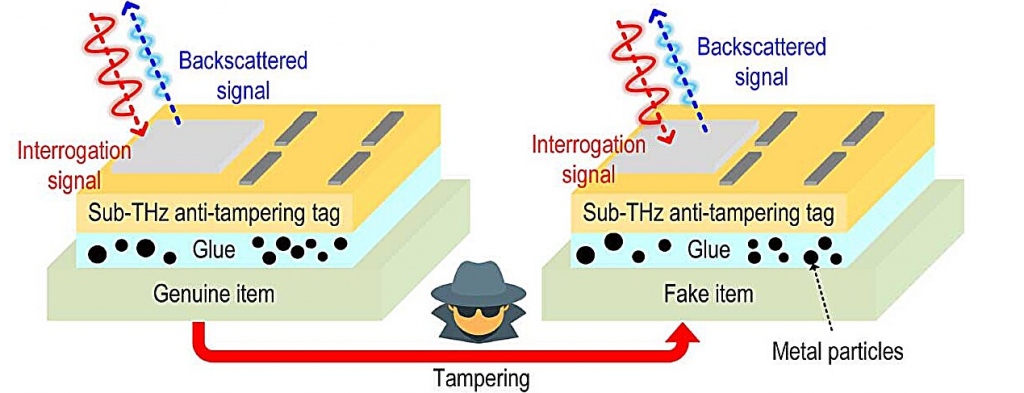Scientists have created a unique tag to combat counterfeiting.
A few years ago, a team of researchers from the Massachusetts Institute of Technology (MIT) created a cryptographic identification tag that turned out to be significantly smaller and cheaper than traditional radio frequency tags (RFID), usually used to confirm the authenticity of products.
The miniature tag, which provides increased security compared to RFID, operates on terahertz waves, which are characterized by a smaller size and higher propagation speed than radio waves. However, this terahertz tag was found to have a significant vulnerability similar to that inherent in traditional RFID: an attacker could remove the tag from a genuine product and re-paste it to a fake, as a result of which the authentication system would not notice the trick.

Now researchers have solved this security problem by applying terahertz waves to develop an anti-tamper identification tag that still has the advantages of miniaturization, cheapness, and security. The innovative approach was to use a unique "fingerprint" obtained by microscopic metal particles mixed with glue to attach the label to the product. These particles reflect terahertz waves, creating a unique pattern that can be used to authenticate the product. If you try to remove the label and re-paste it to another product, the unique pattern will be destroyed, which will immediately reveal a fake.
The new technology was described in detail in a study presented at the IEEE Solid State Circuits conference. The project was led by Ruonan Khan, a professor of electrical engineering and computer science, along with a group of talented students.
The new terahertz tag is only 4 square millimeters in size, which makes it exceptionally compact and can be used on a variety of objects, including very small items such as medical devices.
Interestingly, it was decided to use artificial intelligence to match unique glue patterns. Working with colleagues from MIT's Computer Science and Artificial Intelligence Lab, the team developed a machine learning model that can compare and analyze patterns with more than 99% accuracy. This means that the system can reliably detect whether a tag has been damaged or moved, which is a key element in preventing forgeries.
However, there are certain limitations, such as the need to locate the sensor at a distance of no more than 4 centimeters from the tag for accurate reading and an angle of less than 10 degrees between the sensor and the tag to avoid signal loss. Despite these limitations, researchers see great potential in the further development and application of terahertz waves not only for product identification and security, but also in other areas.
A few years ago, a team of researchers from the Massachusetts Institute of Technology (MIT) created a cryptographic identification tag that turned out to be significantly smaller and cheaper than traditional radio frequency tags (RFID), usually used to confirm the authenticity of products.
The miniature tag, which provides increased security compared to RFID, operates on terahertz waves, which are characterized by a smaller size and higher propagation speed than radio waves. However, this terahertz tag was found to have a significant vulnerability similar to that inherent in traditional RFID: an attacker could remove the tag from a genuine product and re-paste it to a fake, as a result of which the authentication system would not notice the trick.

Now researchers have solved this security problem by applying terahertz waves to develop an anti-tamper identification tag that still has the advantages of miniaturization, cheapness, and security. The innovative approach was to use a unique "fingerprint" obtained by microscopic metal particles mixed with glue to attach the label to the product. These particles reflect terahertz waves, creating a unique pattern that can be used to authenticate the product. If you try to remove the label and re-paste it to another product, the unique pattern will be destroyed, which will immediately reveal a fake.
The new technology was described in detail in a study presented at the IEEE Solid State Circuits conference. The project was led by Ruonan Khan, a professor of electrical engineering and computer science, along with a group of talented students.
The new terahertz tag is only 4 square millimeters in size, which makes it exceptionally compact and can be used on a variety of objects, including very small items such as medical devices.
Interestingly, it was decided to use artificial intelligence to match unique glue patterns. Working with colleagues from MIT's Computer Science and Artificial Intelligence Lab, the team developed a machine learning model that can compare and analyze patterns with more than 99% accuracy. This means that the system can reliably detect whether a tag has been damaged or moved, which is a key element in preventing forgeries.
However, there are certain limitations, such as the need to locate the sensor at a distance of no more than 4 centimeters from the tag for accurate reading and an angle of less than 10 degrees between the sensor and the tag to avoid signal loss. Despite these limitations, researchers see great potential in the further development and application of terahertz waves not only for product identification and security, but also in other areas.
